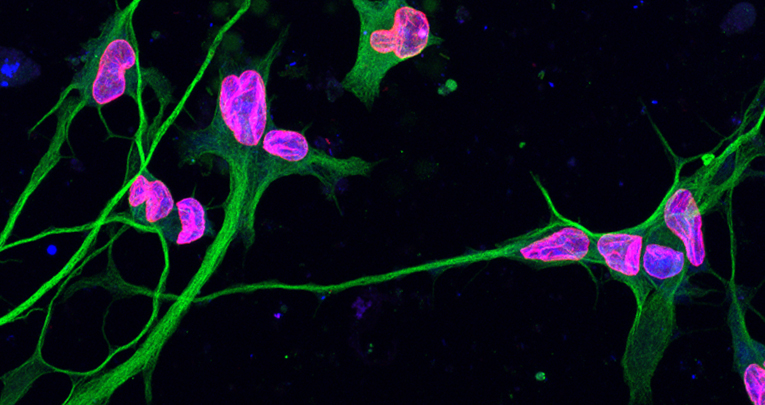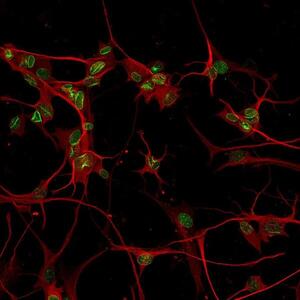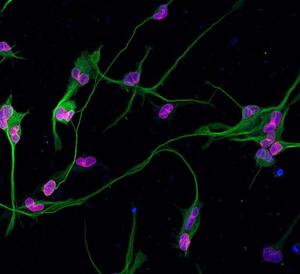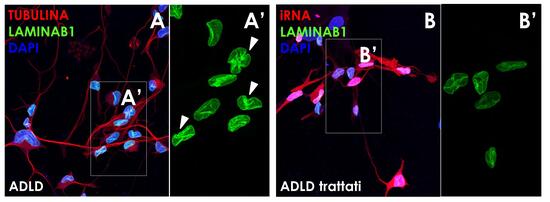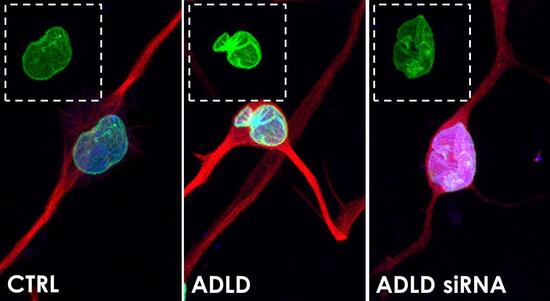24/06/2019
Brain,
29 May 2019
Giorgio E
1
,
Lorenzati M
2
, Rivetti di Val Cervo P
3
, Brussino A
1
, Cernigoj M
3
, Della Sala E
1
, Bartoletti Stella A
4
, Ferrero M
1
, Caiazzo M
5,6
, Capellari S
4,7
, Cortelli P
4,7
, Conti L
8
, Cattaneo E
3,9
,
Buffo A
2
, Brusco A
1,10
.
Allele-specific silencing by RNA interference (ASP-siRNA) holds promise as a therapeutic strategy for downregulating a single mutant allele with minimal suppression of the corresponding wild-type allele.
This approach has been effectively used to target autosomal dominant mutations and single nucleotide polymorphisms linked with aberrantly expanded trinucleotide repeats.
Here, we propose ASP-siRNA as a preferable choice to target duplicated disease genes, avoiding potentially harmful excessive downregulation. As a proof-of-concept, we studied autosomal dominant adult-onset demyelinating leukodystrophy (ADLD) due to lamin B1 (
LMNB1
) duplication, a hereditary, progressive and fatal disorder affecting myelin in the CNS. Using a reporter system, we screened the most efficient ASP-siRNAs preferentially targeting one of the alleles at rs1051644 (average minor allele frequency: 0.45) located in the 3′ untranslated region of the gene.
We identified four siRNAs with a high efficacy and allele-specificity, which were tested in ADLD patient-derived fibroblasts. Three of the small interfering RNAs were highly selective for the target allele and restored both LMNB1 mRNA and protein levels close to control levels. Furthermore, small interfering RNA treatment abrogates the ADLD-specific phenotypes in fibroblasts and in two disease-relevant cellular models: murine oligodendrocytes overexpressing human LMNB1, and neurons directly reprogrammed from patients’ fibroblasts.
In conclusion, we demonstrated that ASP-silencing by RNA interference is a suitable and promising therapeutic option for ADLD.
Moreover, our results have a broad translational value extending to several pathological conditions linked to gene-gain in copy number variations.
Neurons reprogrammed from controls’ fibroblasts.
We can appreciate lamin B1 with its characteristic perinuclear localization (green) and tubulin, a neuronal marker, in red.
Neurons reprogrammed from controls’ fibroblasts.
We can appreciate lamin B1 with its characteristic perinuclear localization (magenta), tubulin (a neuronal marker in green), and DAPI in blue (nuclear staining).
Panel 1. The strategy of RNA interference in neurons reprogrammed from fibroblasts.
Figures A-A’: reprogrammed neurons of ADLD patients; lamin B1 levels are increased (A’), that leads to the formation of the characteristic pathological blebs (A’, arrows). Figures B-B’: iRNA treatment restores lamin B1 physiological levels and re-establishes the correct nuclear phenotype
. Tubulin (neuronal marker, fig. A) and iRNA (fig. B) in red, lamin B1 in green and DAPI (nuclear staining) in blue.
Panel 2. The strategy of RNA interference in neurons reprogrammed from fibroblasts.
Reprogrammed neurons of healthy controls and ADLD patients (CTRL and ADLD); in ADLD condition, lamin B1 levels are increased compared to CTRL condition, that leads to the formation of the characteristic pathological blebs. iRNA treatment (ADLD siRNA) restores lamin B1 physiological levels and re-establishes the correct nuclear phenotype
. Tubulin (neuronal marker, CTRL and ADLD) and iRNA (ADLD siRNA) in red, lamin B1 in green and DAPI (nuclear staining) in blue.
1
University of Torino, Department of Medical Sciences, 10126, Torino, Italy.
2
University of Torino, Department of Neuroscience Rita Levi Montalcini and NeuroscienceInstitute Cavalieri Ottolenghi (NICO), Orbassano, 10043, Torino, Italy.
3
University of Milan, Department of Biosciences, Laboratory of Stem Cell Biology and Pharmacology of Neurodegenerative Diseases, 20122 Milan, Italy.
4
IRCCS Istituto delle Scienze Neurologiche di Bologna, Bellaria Hospital, 40139, Bologna, Italy.
5
Department of Pharmaceutics, Utrecht Institute for Pharmaceutical Sciences (UIPS), Utrecht University, Universiteitsweg 99, 3584, CG, Utrecht, The Netherlands.
6
Department of Molecular Medicine and Medical Biotechnology, University of Naples 'Federico II', 80131, Naples, Italy.
7
University of Bologna, Department of Biomedical and Neuromotor Sciences, 40123, Bologna, Italy.
8
University of Trento, Centre for Integrative Biology (CIBIO), Laboratory of Computational Oncology, 38123, Trento, Italy.
9
National Institute of Molecular Genetics (INGM) Romeo and EnricaInvernizzi, 20122, Milano, Italy.
10
Città della Salute e della Scienza University Hospital, Medical Genetics Unit, 10126, Torino, Italy.
